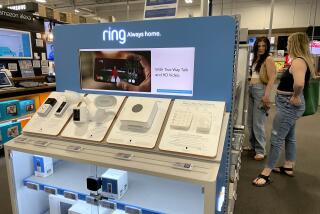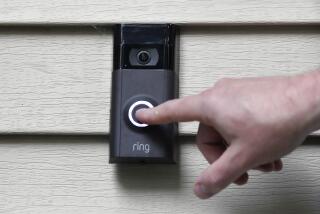Will These Thingies Improve Your Life?
- Share via
If this week’s Consumer Electronics Show had a theme, it was “This year, it’s not a mock-up,” which is what barkers in booths all over Las Vegas kept chanting at passersby.
Lacking any single new ideology or revolutionary theory--promoters at recent shows have raved about portable computing, wireless connectivity and home networking--exhibitors at this year’s CES did not focus on a major theme so much as declare that they were ready to deliver all the goodies they have been promising for so long.
The question is whether any of these soon-to-be-born gadgets make our lives better--or just more cluttered and ultimately confusing.
Consider the eCase, a pocket-size computer that offers what purports to be the world’s largest portable display, addressing a critical issue for mobile computing. The device has a postage stamp-size window at the top. Hold that window a few inches from your eye and you see a crisp color display.
At that distance, the tiny screen appears to be a 19-inch monitor sitting about two feet in front of you. The model I tested had a live Internet connection, and I could easily navigate a Web site using a well-designed series of buttons.
Holding a small screen close to your eye to make it seem like a huge screen isn’t new, but eCase is a great example of where tech is going. In a few years, your Internet-enabled cell phone probably will come with two displays: a standard one for everyday use and something like this postage stamp thingy for serious Web browsing.
That means you can be connected every waking minute of every day, whether walking down the street or driving to work. Sure, it’s a cool concept and it gives you access to the information you want when you want it. But for many people, being wired 24/7 is not necessarily a good thing.
Even though consumer electronics manufacturers want us to spend all of our money and time on gadgetry, many provided ample evidence this week that making products more user-friendly is not at the top of their list.
For instance, despite recognizing that the explosion of new storage formats such as compact flash cards, memory sticks and even teeny-tiny floppies is making consumers crazy, CES saw the introduction of new and, of course, incompatible storage formats.
This is just what we’ve all been waiting for: More devices based on overpriced proprietary technology that works only with one brand of equipment. It’s like having to buy a special brand of electricity for every appliance in your house.
And then there are devices that, having arrived, don’t seem to be especially practical. 3Com’s Audrey device is a cool-looking computer that uses a pen-based data input and an Internet connection to let you surf the Web from your kitchen. The theory behind Audrey is that it’s going to replace the cork board and refrigerator magnets most people use, plus let you dash off an e-mail to Mom asking how long the turkey has to thaw.
Audrey is designed to be so easy to use that people who have been afraid of computers will embrace it. But it’s hard for me to believe that anybody who doesn’t understand the power of the Internet would slap it in their kitchen. Anybody who already has a computer probably will find Audrey’s limited interface pretty annoying.
Indeed, it speaks volumes about this show--and where we are technologically--that many of the most compelling items were designed to make keeping track of all our gadgets just a little easier. Take the Sticky Pad from American Covers.
It’s just a piece of thin, flexible plastic about 5 inches by 4 inches, smooth on one side, rough on the other. Slap the smooth side down on a car’s dashboard--it clings using that electrostatic effect you learned about in high school physics--and you’ve got a surface that will keep stuff from sliding around.
Sticky Pad uses no traditional adhesives, but if you toss your cell phone onto it, it will cling there, even if the sheet is mounted at a 45-degree angle. And, at five bucks, it’s affordable.
The folks displaying these things had mobs of people around them. It was a good demonstration of what consumers really want personal technology to be: easy to use, dependable, effective and reasonably priced. Unfortunately, there weren’t a whole lot of other products at CES that met those criteria.
Welcome to the future. This time, it’s not a mock-up.
*
Dave Wilson is The Times’ personal technology columnist.






